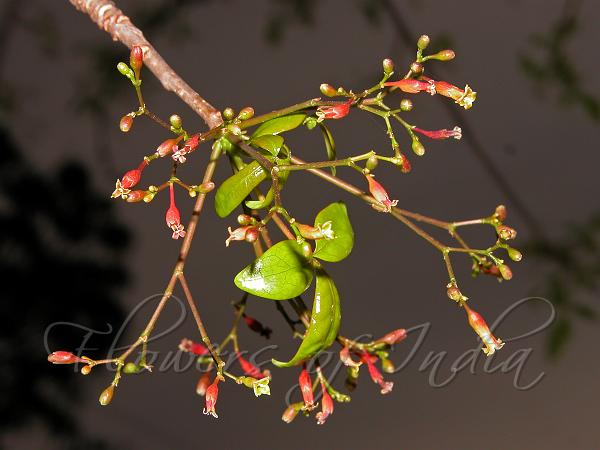|
| South-Indian Commiphora |
|

|

| File size | 723567 |
| Original date | 3/16/10 7:53 AM |
| Resolution | 2360 x 1770 |
| Flash | Flash fired |
| Focal length | 27.3mm |
| Exposure time | 1/4000s |
| Aperture | 7.4 |
| Focus Distance | |
| Metering Mode | Spot |
| Camera make | NIKON |
| Camera model | E5700 |
| Sensor type |
|
|
|
|
Photo: |
Botanical name: Commiphora caudata Family: Burseraceae (Torchwood family)
Synonyms: Balsamea caudata, Protium caudatum, Protionopsis caudata
Synonyms: Balsamea caudata, Protium caudatum, Protionopsis caudata
South-Indian Commiphora is a deciduous tree growing
from 12-20 m tall. The bole can be 15-25 cm in diameter. leaves are
3-7-foliolate, leaflets hairless more or less abruptly tapering, cyme
branched many times symmetrically greatly exceeding the leaves. Leaves
long-leaf-stalkd with short lateral leaflets, the at branch-ends one
with a long leaflet-stalk, ovate, entire. Cymes bracteate at the
branches, the bracteoles beneath the flowers very minute. Flowers are
polygamous, yellowish-red, small. Sepals are triangular, pointed, as
long as broad. Petals are about twice as long as sepals. Drupe is about
the size of a pea, nearly globular, subtended by the persistent
sepal-cup. South-Indian Commiphora is found in Peninsular India and Sri
Lanka.
Medicinal uses: In traditonal medicine, it is
used in curing various ailments like arthritis; hyperlipidemia, pain,
healing of wounds, coronary artery, gynecological diseases and also
widely used to treat pain full inflammatory conditions.
In traditonal medicine, it is
used in curing various ailments like arthritis; hyperlipidemia, pain,
healing of wounds, coronary artery, gynecological diseases and also
widely used to treat pain full inflammatory conditions.
Medicinal uses:
 In traditonal medicine, it is
used in curing various ailments like arthritis; hyperlipidemia, pain,
healing of wounds, coronary artery, gynecological diseases and also
widely used to treat pain full inflammatory conditions.
In traditonal medicine, it is
used in curing various ailments like arthritis; hyperlipidemia, pain,
healing of wounds, coronary artery, gynecological diseases and also
widely used to treat pain full inflammatory conditions. | Identification credit: Milind Girdhari | Photographed in Pune, Maharashtra. |
• Is this flower misidentified? If yes,